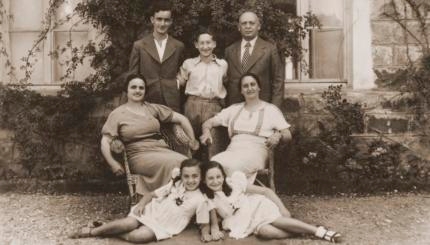Team Be’chol Lashon: We are excited to hear that you have a new album that has taken your work in a new direction. Tell us about it.
Aroeste: Indeed! I’ve written a holiday album! While all my music has been considered “Jewish” by virtue of having been written and sung in Ladino (Judeo-Spanish), I have, in the past, always written from an intentionally secular angle. This year, however, I found a new way to express myself by thinking about the messages I wanted to convey for my favorite Jewish holidays. And with a specific bent in each. I wanted to celebrate, out loud, the Ladino poetry of Purim, my love of Hanukkah bimuelos (the delicious Sephardic fried dough), the international rhythms of Shabbat, and so much more. I have faced a lot of fear and self-doubt in my career, but I don’t know why I had been so scared to write Jewish songs before.
Team Be’chol Lashon: How did you come to this new direction?
Aroeste: I was awakened this past year in a new way; I suppose that last year I heard the shofar a little bit louder. So much of my personal, spiritual and artistic journey over the last decade has been about finding ways to celebrate my Sephardic heritage. I’ve been steadfast in my commitment, but somehow this year my vision came into stronger focus.
Not only did I take a new leap into composing music with a distinctly Jewish thread, but I also decided for the first time to incorporate English into my work. My new album is actually bilingual! By writing songs with interwoven English, more people can learn about the beauty that is Ladino. I believe it’s a new entry point to give even more people access into this culture.
Team Be’chol Lashon: What can you tell us about your song for Rosh Hashanah?
Aroeste: My song, Anyada Buena, is really a blessing. “May your year be sweet, komo la miel. (Like the honey)/ May you hear the shofar, ke te desperte el (And it awakens you). It’s a song to wish someone a good sweet year, and one that is filled with vision, clarity, and peace.
Team Be’chol Lashon: And yet the album doesn’t start with the New Year, it starts with a song, why?
Aroeste: For me starting with Havdalah made sense, because it’s the start of something new. It’s a new week, a new attitude. The album starts with Havdalah and ends with Shabbat. And in between are some of my favorite holidays from Tu B’Shevat, to Passover, Sukkot and more.
Team Be’chol Lashon: What does the album title, Together/Endjuntos, mean to you?
Aroeste: The word “together,” or endjuntos in Ladino, is the theme that threads through the songs. When I think of holidays, I think of spending time together with family and friends. “Together” also represents the bilingual aspect of the album, and the fact that the English and Ladino are interwoven throughout the songs. In a larger sense though, my hope is that these songs will be included together with other traditional holiday offerings people have come to know and love. The music purposely ranges in styles from merengue, to bhangra, to French electro pop, to fiddle folk and more—all to show that these sounds and tapestries all belong together in the canon of Jewish sounds.
We wish you all the success with this album and in the year to come!
Aroeste: Amen!
Anyada buena, dulse i alegre; Seyas bendicho, seyas kontente.
A good year, sweet and happy; May you be blessed, may you be content.
Sarah Aroeste’s Ladino/English holiday album, Together/Endjuntos, was released September 19th, 2017. It is already available on Amazon and iTunes.




